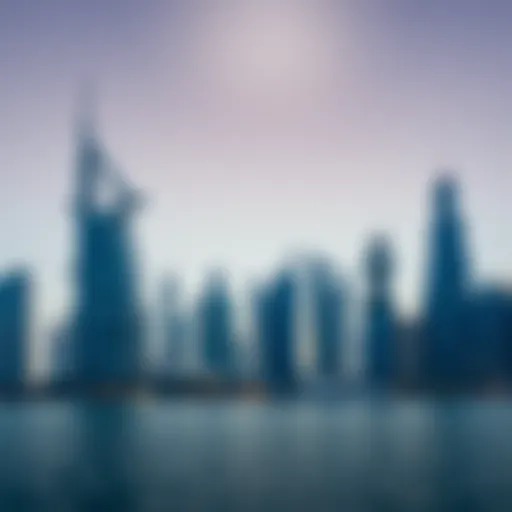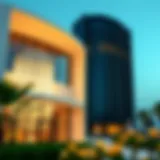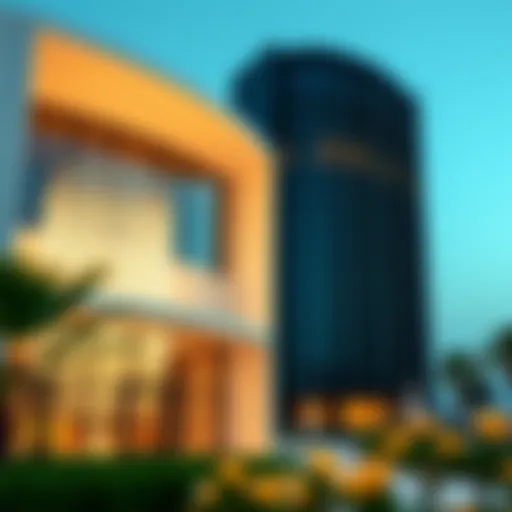The Importance of Dubai's Corniche Terrace in Urban Design
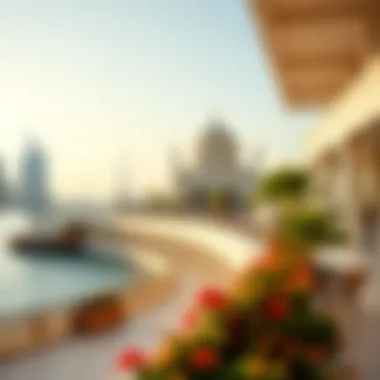
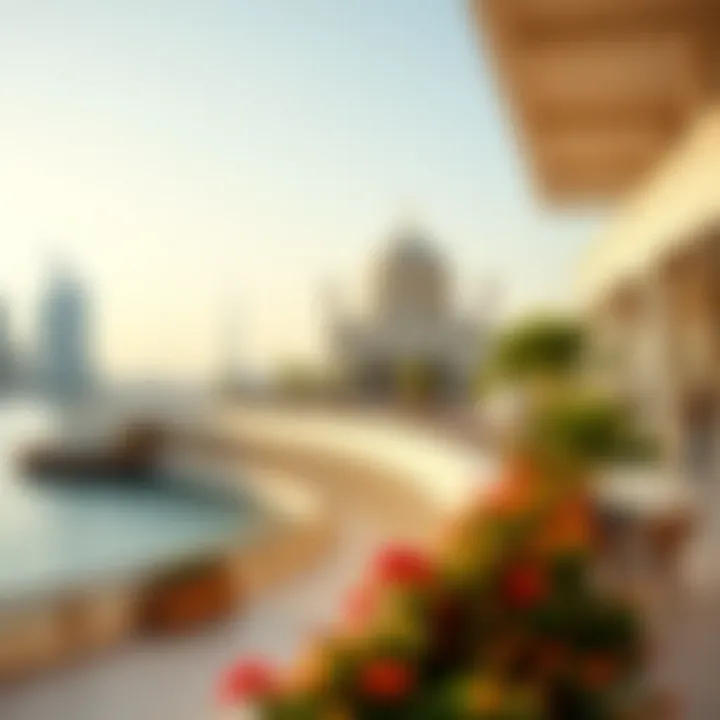
Intro
The terrace on the corniche stands as a testament to Dubai's rapid metamorphosis into a global hub. It’s not merely an open space; it embodies the city’s architectural essence while fostering a unique cultural narrative. As urbanization sweeps through this emirate, the terrace serves as a vital link between city dwellers and their environment, capturing the pulse of local life.
This exploration aims to peel back layers, revealing the significance of the terrace in the context of real estate and urban planning. The elegant design, infused with thoughtful elements, marries functionality with aesthetics. This space has become a gathering point, catering to both residents and tourists, making it a centerpiece of daily social life. Understanding its role can shed light on broader market trends and investment opportunities.
As we dive deeper into the subsequent sections, we’ll unravel how the terrace not just enhances property values but also defines lifestyle choices for a growing population. Drawing from current market trends, insights, and forthcoming projections, this narrative will guide investors, homebuyers, and urban planners through the intricate dynamics of Dubai’s real estate landscape.
Intro to the Terrace on the Corniche
The Terrace on the Corniche serves as more than just an architectural feature in Dubai; it represents a vibrant intersection of culture, community, and real estate dynamics. As this bustling city continues to expand and innovate, the significance of spaces like the Terrace cannot be overstated. It is a microcosm of urban life, fostering social interactions and promoting an inclusive atmosphere for both residents and visitors alike.
Walking along the Corniche, visitors find themselves immersed in the beauty of the city while witnessing the architectural prowess that defines Dubai. The terrace itself offers expansive views of the shimmering coastline and the iconic skyline, becoming a pivotal spot for leisure, reflection, and community engagement. Its design is thoughtfully executed, balancing functional requirements with aesthetic charm, thus enhancing the overall appeal of the area.
One of the notable benefits of the terrace includes its role as an inviting space for various community activities. Whether hosting art exhibits, cultural festivals, or casual gatherings, the terrace provides a platform that elevates public engagement. Such spaces contribute to the fabric of urban life—encouraging individuals to come together, share experiences, and foster connections.
Furthermore, there are several considerations to keep in mind regarding the terrace's relevance. The integration of sustainable practices in its design exhibits a commitment to environmental stewardship, showcasing how urban development can coexist harmoniously with nature. Additionally, for potential investors and homebuyers, proximity to unique amenities such as the terrace on the Corniche can significantly influence property desirability and value.
By understanding the multifaceted significance of the Terrace on the Corniche, stakeholders from various sectors can better appreciate its role in shaping not just individual landscapes but also the broader urban narrative of Dubai. A closer look at the history, architecture, cultural implications, and economic aspects reveals layers of complexity that make this terrace a crucial part of the dream city.
"In a place where the skyline touches the clouds, the Corniche becomes the pulse of the city."
As we continue to explore this essential urban characteristic, we delve deeper into its historical background to see how it transformed from a mere concept to a central fixture in Dubai's cultural and economic tapestry.
Historical Background of the Corniche
Understanding the historical background of the Corniche is essential to grasping its role in Dubai’s urban fabric. This promenade, stretching along the coastline, is not just a mere walkway or an aesthetic addition to the city; it represents a journey through time, showcasing the transformation of Dubai from a modest settlement to a bustling metropolis. Such a narrative serves as the cornerstone for appreciating the vital role played by the terrace in modern urban life and its implications for real estate and community engagement.
Pre-Development Era
Before the development of the Corniche, the area was characterized by traditional fishing and pearl diving activities. The coastal stretch was a hub for local fishermen, whose day-to-day lives revolved around these ancient practices.
- The traditional architecture of houses clustered near the shoreline stood as a testimony to the local culture and lifestyle.
- There wasn’t much of a public space; the interaction between the community was confined mainly to the water's edge.
The very essence of urban life in this period revolved around these activities, with social gatherings primarily occurring at the docks or on the boats. This close-knit community life was a stepping stone towards the vibrant, urban environment we witness today. The transformation was not merely architectural; it reflected a shift in social dynamics as well, paving the way for modern living.
Transformation Over the Decades
As Dubai began to embrace modernization in the late 20th century, the Corniche underwent significant transformation, morphing into an emblem of the city’s rapid growth. Urban planners and architects recognized the need for a public space that fostered community interactions and tourism.
- The initial phases saw the incorporation of green spaces, leisure activities, and recreational facilities, designed to cater to the burgeoning population and tourists flocking to the city.
- Over time, the walkway evolved into a beautifully landscaped promenade adorned with palm trees, benches, and art installations.
The impact of this transformation on the local economy cannot be overstated. The terrace on the Corniche is not just a leisure destination; it has become a critical area for investments in real estate, drawing in both local and international developers. The influx of more residents and businesses in the vicinity significantly contributed to an increased demand for property, further intensifying the economic activities surrounding the area.
In summary, the historical backdrop of the Corniche underscores its significance as a dynamic space that reflects Dubai's journey towards modernization. It serves as a linchpin for community interaction and a catalyst for economic expansion. As we dive deeper into the architectural, cultural, and economic implications, it becomes apparent that the terrace on the Corniche is more than a physical structure; it’s a living depiction of Dubai’s ethos and future ambitions.
Architectural Features of the Terrace
The architectural features of the terrace on the Corniche are not just ornate details; they are the very backbone of Dubai’s urban identity. As the city strides confidently into the future, this terrace combines aesthetics with functionality, acting as a bridge between nature and the built environment. Its design elements, integration with surroundings, and emphasis on sustainability are paramount in understanding the significance it holds in the broader picture of urban development.
Design Elements
Materials Utilized
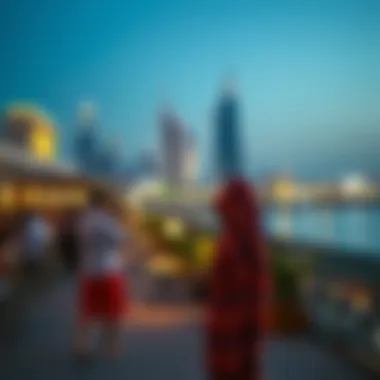
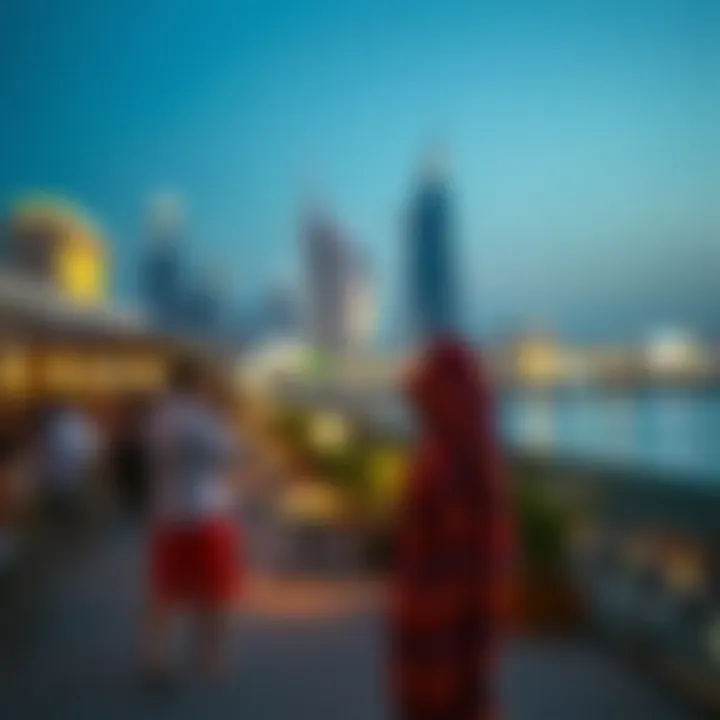
The choice of materials for the terrace represents a thoughtful approach to both durability and visual appeal. Local stones, tempered glass, and weather-resistant metals are prevalent here. One standout aspect is the use of light-colored marble, which not only gives an air of elegance but also reflects the sunshine, brightening the area even under Dubai's sometimes harsh light.
These materials are beneficial because they align with sustainable practices, needing less maintenance and promising longevity. They also support the idea of integrated urban design; for example, the marble often comes from local quarries, promoting regional industries and reducing transportation emissions. A disadvantage might be the initial cost, but this investment pays off in terms of durability and aesthetic value.
Layout Considerations
The layout of the terrace is a testament to meticulous planning. Designed to encourage free movement, the walkway meanders gracefully, allowing visitors to enjoy both expansive views and intimate spaces. Its key characteristic is the accessibility it offers; wide paths cater to pedestrians and cyclists alike, promoting healthier lifestyles.
What stands out here is the consideration of varied spaces for different activities, from quiet spots for contemplation to vibrant areas for gatherings. However, with increased foot traffic, maintaining cleanliness and safety can become challenges, requiring constant vigilance from urban planners.
Landscaping Features
Landscaping on the terrace goes beyond mere embellishment; it's a crucial feature that enhances the area's ecological value. One striking characteristic is the incorporation of native plants, which require less water and maintenance. This not only supports local biodiversity by providing habitats for various species but also integrates the terrace into the native landscape.
The benefits of such landscaping practices include the reduction of heat in the surrounding area, which can be significant in desert climates. Yet, a downside may arise from the need for careful planning to ensure that non-native plants do not invade, disrupting local ecosystems.
Integration with Surrounding Structures
The terrace is designed to seamlessly blend with nearby urban structures, creating a harmonious atmosphere that encourages interaction. The use of similar materials with surrounding buildings establishes a cohesive look, while the layout ensures smooth transitions between different spaces like cafes, parks, and retail areas.
This integration brings a sense of unity to the Corniche, elevating the overall user experience. However, careful thought must be put into zoning regulations and the potential for overdeveloping the area, which might detract from the terrace's natural appeal.
Ultimately, the architectural features of the terrace on the Corniche reflect a balance of aesthetics, functionality, and sustainability. They are not merely for eye-catching appeal but serve concrete purposes in promoting community interaction, enhancing property value, and fostering ecological stewardship.
Cultural Significance of the Terrace
The terrace on the Corniche stands out not just for its structural elegance, but also for its pivotal role in shaping cultural dynamics in Dubai. This space is a melting pot of experiences, blurring the lines between leisure, art, history, and community. The cultural significance of the terrace cannot be overstated, as it serves as a gathering place, a stage for performances, and a canvas for artistic expressions, all of which foster a rich communal spirit.
A Space for Community Engagement
The terrace acts as a waterfront hub where social ties flourish. Whether you're a local resident, an expat, or a visiting tourist, you're likely to witness a myriad of activities that reflect the community's diverse tapestry. On weekends, families set up picnics, children laugh and play, while joggers and cyclists traverse the promenade. It's a microcosm of Dubai's multicultural identity.
Regular events and activities, such as cultural festivals and community markets, are often hosted on the terrace.
"The terrace is more than just a scenic view; it's where the heart of the community beats."
These events, frequently showcasing traditional UAE music, handicrafts, and gastronomic delights, draw large crowds, creating a shared sense of belonging among the locals and visitors alike. The terrace enhances urban life by providing a friendly venue for interaction, thus fostering an atmosphere of unity and understanding.
Moreover, public art installations scattered throughout the terrace add another layer of vibrancy, allowing for ongoing dialogues about art, history, and identity. This immediacy of art creates an accessible dialogue about modern Arabian culture, spurring conversations around globalization and tradition.
Artistic and Historic Representations
In terms of artistic representation, the terrace serves as an open gallery, featuring works that underscore the cultural narratives of Dubai. From sculpture to mural art, these pieces often reflect social issues, historical events, or local legends, resonating with both residents and tourists. A striking example includes the vibrant murals that celebrate the Emirati heritage, showcasing scenes from daily life, folklore, and modern achievements.
Additionally, the terrace has become a landmark for numerous historic events that reflect the transformation of the city. Art has the power to unify, and at the terrace, it is not uncommon to see community members gathering to engage with these artistic representations, discussing their meanings and relevance.
The layer of history encapsulated within the terrace is palpable. It serves as a reminder of Dubai's rapid transformation from a trading port to a monumental urban center, embodying the resilience and creativity of its people. The use of traditional materials and techniques in some installations also prompts reflections on sustainability and continuity within a fast-paced modern world.
By providing a platform for storytelling through art, the terrace ensures that narratives of Dubai's past and its aspirations for the future remain intertwined. Here, history is not a relic; it's a living narrative deeply ingrained in the urban landscape, and the terrace stands at the crossroads of this dialogue.
As such, the terrace not only enhances Dubai's aesthetic appeal but also serves as an integral part of its cultural framework, fostering understanding and appreciation among its diverse populace.
Economic Implications of the Terrace
The terrace on the Corniche is not just a picturesque spot for a stroll or a gathering; it plays a pivotal role in shaping the economic landscape of Dubai. Its development has created a ripple effect, strengthening the local economy and driving real estate trends. Understanding these implications provides insight into how urban planning can influence broader economic factors, affecting residents and investors alike.
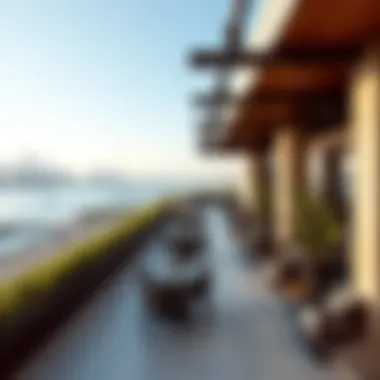
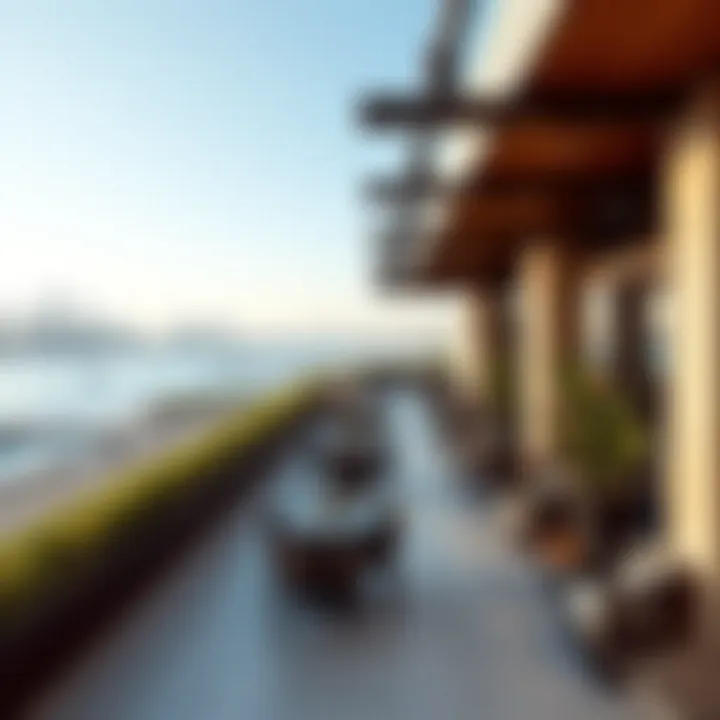
Influence on Local Property Values
The terrace has a profound impact on property values in surrounding areas. Homes, apartments, and commercial spaces located close to this vibrant urban feature tend to command higher prices. The reason for this can be attributed to several factors:
- Accessibility: Proximity to the terrace enhances the appeal of nearby properties. People are naturally drawn to locales that offer easy access to recreational and communal areas.
- Aesthetic Value: Properties near beautiful landscapes and well-maintained public spaces often see an appreciation in value. The terrace adds a touch of elegance to the neighborhood, making it more attractive to potential buyers.
- Lifestyle Quality: Living near the terrace means an improved urban lifestyle, which buyers are willing to pay a premium for. It’s not just about having a roof over one’s head anymore—it’s about the experience a location provides.
"The terrace isn’t merely an addition to Dubai’s landscape; it’s a catalyst for economic growth, enhancing property values in unexpected ways."
In analyzing the data, various studies reveal that properties within a half-kilometer radius of the terrace often exhibit a property value increase of 10% to 20%. This earns the terrace a standing as a cornerstone in the real estate strategy of the city.
Attractive to Investors and Developers
The terrace has become a goldmine for investors and developers looking to capitalize on Dubai's growth trajectory. The space draws significant attention for various reasons:
- High Demand: The allure of residential and commercial spaces near picturesque locations acts as a magnet for investors. Developers recognize the terrace’s ability to attract clientele seeking luxury and lifestyle amenities.
- Real Estate Opportunities: With ongoing developments and renovations taking place around the terrace, there’s a myriad of opportunities for savvy investors. These projects promise to elevate the overall district, enhancing both traffic and footfall.
- Government Incentives: The Dubai government has demonstrated a keen interest in nurturing such developments, offering incentives for projects that aim to complement urban infrastructure like the terrace. Building near this area may also come with advantages such as tax breaks or streamlined permitting processes.
Investors who understand how the terrace influences local dynamics can navigate the market more effectively. They not only see a potentially lucrative investment but also contribute to enhancing the community’s lifestyle through thoughtful development.
In summary, the terrace on the Corniche serves as a key driver for local property values and an attractive focal point for investment and development in Dubai’s bustling real estate landscape. By evaluating these economic implications, stakeholders can make informed decisions that align with local growth objectives.
Environmental Considerations of the Terrace
The importance of the terrace on the Corniche goes beyond mere aesthetic appeal; it's intertwined with essential environmental considerations that shape both urban life and ecological balance. In a sprawling metropolis like Dubai, integrating nature into urban settings is crucial. This terrace not only enhances the visual landscape but serves as a sanctuary for both wildlife and residents alike. By choosing sustainable practices in its development and maintenance, the terrace can significantly contribute to environmental sustainability.
Sustainable Landscaping Practices
To achieve a harmonious blend of nature and urban living, sustainable landscaping practices have been employed in the development of the terrace. Incorporating native plants not only reduces water consumption but also promotes local biodiversity. For instance, using species like date palms or desert wildflowers can attract native insects, which play a vital role in pollination.
Here are a few sustainable landscaping practices observed on the terrace:
- Drought-resistant Plants: Utilizing vegetation that thrives in arid conditions helps conserve water.
- Recycling Materials: From creating walkways to furniture, repurposed materials reduce waste.
- Rainwater Harvesting: Collecting rainwater during Dubai's sporadic rains allows for effective irrigation.
These practices collectively help maintain the ecological integrity of the area, ensuring the terrace not just thrives but positively impacts its surroundings.
Impact on Urban Ecology
Urban ecology, as it relates to the terrace, involves the interplay between human-made environments and natural ecosystems. A conscious design aimed at enhancing this relationship can lead to beneficial outcomes for both residents and local wildlife.
Biodiversity
Biodiversity is paramount in sustaining a healthy urban environment. The terrace features a variety of plant species that create niches for different types of wildlife. This richness is not merely decorative; it's a crucial ecological strategy. By supporting various flora and fauna, the terrace becomes a microhabitat that promotes ecological stability. One key characteristic of this biodiversity is its resilience; diverse ecosystems can withstand environmental changes better than monocultures, making them a wise choice in an unpredictable climate.
Moreover, the terrace functions as a migratory stop for birds and insects, bridging their habitats with urban spaces. While these aspects largely contribute to enhancing biodiversity in urban landscapes, challenges such as invasive species can disrupt this delicate balance. Therefore, ongoing management is necessary to maintain these benefits.
Natural Habitats
Natural habitats within the terrace ecosystem play a critical role in supporting wildlife. By integrating elements such as small ponds or native gardens, the terrace can provide essential resources for local species. The presence of these unique features encourages diverse wildlife interactions, fostering a vibrant ecology right in the heart of the city.
A noteworthy characteristic of these habitats is their multifunctionality. Not only do they support living organisms, but they also offer educational and recreational spaces for visitors and residents. While these habitats present countless advantages, they do require maintenance and thoughtful planning to prevent potential issues like pollution or habitat degradation.
Overall, these environmental considerations intricately link the terrace to its broader urban context, promoting sustainability and ecological health in Dubai's ever-evolving landscape.
"The terrace not only enhances the urban aesthetic but becomes a linchpin for ecological balance, offering sandy solutions within the concrete jungle."
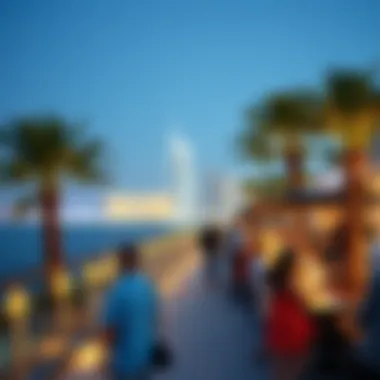
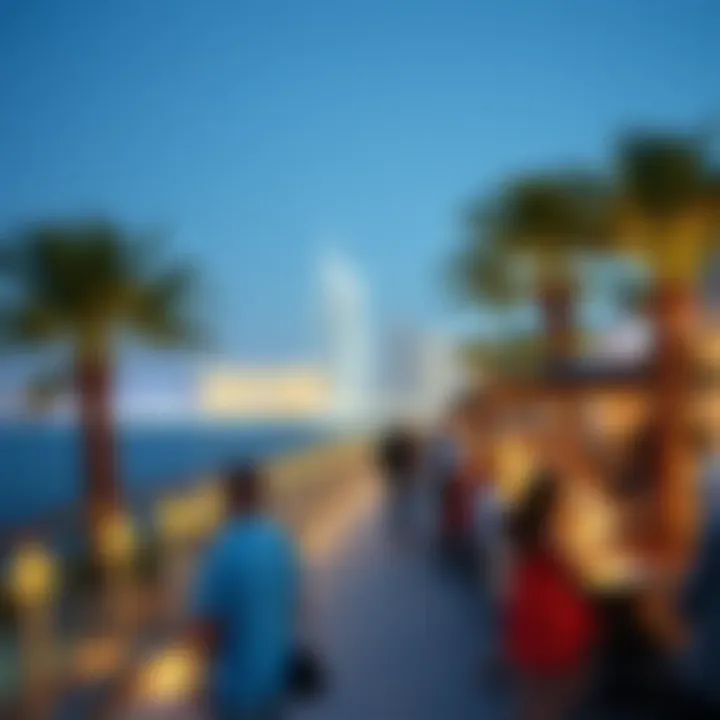
For further insights into urban ecology, visit resources like National Geographic or explore the intricate relationships found in nature at Wikipedia on Urban Ecology.
Continued focus on these aspects ensures the terrace remains a vital resource for both the environment and the community.
The Role of the Terrace in Urban Planning
The terrace on the Corniche stands as a pivotal point in Dubai's urban planning landscape, functioning not merely as a recreational space but as a vital component regulating the flow of people, ideas, and economic activity. Its integration within the larger urban matrix is a case study in how public spaces can enhance the quality of life while stimulating economic growth. This section delves into two major elements: zoning and land use, alongside the connectivity it offers to other urban areas.
Zoning and Land Use
Zoning regulations govern how land can be utilized within urban contexts, and the terrace has a unique designation that invites diverse activities. The careful planning of this area underscores its intended use as a communal hub, wherein locals and tourists alike can engage with the urban fabric of Dubai.
- Mixed-Use Development: By surrounding the terrace with residential, commercial, and entertainment sectors, the planners ensure a vibrant mix. Coffee shops, boutiques, and open-air galleries thrive here, creating what some might call an urban ecosystem.
- Public vs. Private Spaces: The design contrasts private property usage with open public space. This encourages social interactions, promoting the terrace as an appealing destination for individuals seeking leisure, cultural events, or simple respite.
- Regulatory Framework: Zoning laws in Dubai dictate height restrictions for buildings around the terrace. This promotes visibility and ensures that nothing obstructs the view of the iconic skyline.
These factors lead to increased foot traffic, making the terrace a central axis for commerce and socialization, thus enhancing the economic fabric of the community.
Connectivity to Other Urban Areas
Connectivity is not merely about physical infrastructure; it's also about how spaces inspire movement and interaction. The terrace integrates seamlessly with surrounding urban environments, effectively connecting various districts and fostering a sense of inclusiveness among residents and visitors.
- Transport Links: With nearby metro and bus stations, the accessibility of the terrace enhances its attractiveness. People find it easy to reach this scenic spot without the hassle of long commutes.
- Pedestrian Pathways: The deliberate planning includes well-marked pathways that connect the terrace with neighboring parks and beachfronts. The idea is simple: encourage walking, cycling, and socializing to support a healthier community.
- Cultural Bridges: Public art installations found along these pathways not only beautify the landscape but also celebrate the diverse cultures that coalesce within Dubai. This aspect plays a crucial role in fostering a sense of community.
"By designing the terrace as a connective tissue of the urban plan, urban planners have created not just a physical space, but a social platform that resonates with the city's modern narrative."
Through meticulous zoning and strategic connectivity, the terrace stands as a testament to successful urban planning. It demonstrates how well-thought-out spaces can underpin both community engagement and economic viability, setting a standard for future developments.
Future Developments Around the Terrace
The future developments surrounding the terrace on the Corniche play a pivotal role in shaping the landscape of Dubai's urban environment. As Dubai continues to expand and modernize, the enhancements in this area will not only improve the aesthetic appeal but also create new economic opportunities. The strategic planning of these projects aims to foster a sense of community and bolster the overall livability of the city.
Ongoing Projects and Initiatives
A number of intriguing projects are currently underway, each aimed at revitalizing the terrace and surrounding areas. For instance, the Dubai Canal project is set to expand the waterfront, connecting the terrace to other major attractions and enhancing accessibility. Another promising development is the introduction of mixed-use commercial spaces which intend to house not just retail but also restaurants and leisure facilities, creating a vibrant atmosphere.
Additionally, ongoing landscaping initiatives are focused on increasing green spaces. This entails planting native species and creating shaded areas for public enjoyment, making the terrace not just a picturesque spot but also a refuge from the summer heat. These measures not only improve the visual aspects but promote sustainability in the urban ecosystem.
One notable project relevant to community engagement is the Cultural Hub initiative. This aims to integrate art installations, performance areas, and workshops into the terrace environment, reading the space for local artists and craftsmen to engage with both residents and tourists. Such vibrant activities foster a richer cultural experience that transcends mere architectural beauty.
Potential Challenges and Opportunities
While the future developments around the terrace promise growth and enhancement, there are several challenges that need careful consideration. Balancing development and preservation is crucial; the projects must respect the historical significance of the terrace while also meeting modern demands. There’s always the risk of overwhelming the natural beauty with excessive commercialization. Furthermore, potential litigation problems arise when developers fail to align with zoning regulations, which can delay projects and increase costs.
However, every cloud has a silver lining. These challenges also provide opportunities for innovation and collaboration among various stakeholders. Local government agencies, private investors, and community organizations can come together to forge development strategies that bring value without compromising the essence of the place.
The focus on sustainability can also yield significant benefits. For instance, integrating smart technology into infrastructure can enhance energy efficiency, potentially attracting forward-thinking investors.
In summary, the ongoing projects around the terrace and the associated opportunities and challenges present a dynamic evolutionary stage for this key part of Dubai's urban landscape. By navigating these complexities with care, the area can transform into a flourishing hub that harmoniously blends heritage with modernity.
Closure: The Integral Nature of the Terrace
The terrace on the Corniche stands as a testament to the intricate weave of urban life in Dubai. It is not merely a physical space; it's a living, breathing part of the city that encapsulates the intersection of design, culture, and economic vibrancy. This final section explores the multifaceted importance of the terrace, emphasizing how it nurtures community ties, boosts real estate appeal, and enriches the urban ecosystem.
Community and Cultural Hub
At its core, the terrace functions as a gathering place that encourages community bonding. Residents and visitors alike find solace in its greenery and design. Events hosted here often blend local traditions with contemporary art, drawing a diverse crowd. In doing so, the terrace nurtures cultural exchanges that are vital for a city as cosmopolitan as Dubai. The artistic displays and cultural activities amplify the voices of local artists, supporting a thriving creative scene.
Real Estate Influence
From an economic standpoint, the terrace has a palpable effect on property values in the surrounding neighborhoods. Research shows that proximity to well-designed public spaces can lead to increased demand for real estate. Homes near the terrace are not just structures but are considered gateways to a richer lifestyle. Investors keen on reaping long-term benefits often recognize the terrace as a valuable asset, enhancing the allure of real estate ventures in the area.
Environmental Integration
Additionally, the terrace plays a role in enhancing the urban ecology of Dubai. By integrating sustainable landscaping practices, it not only beautifies the environment but also supports local biodiversity. It acts as a green lung, helping mitigate the effects of urban heat and promoting biodiversity. A carefully designed urban space contributes to the well-being of both nature and the people who live in its vicinity.
Looking Forward
As developments around the terrace continue to evolve, it is important to remain cognizant of its significance. Future projects should aim to uphold the balance between growth and sustainability, ensuring that this vital public space remains accessible and enriching for all. Engaging with local stakeholders will only solidify its role as a cornerstone of urban life in Dubai.
In summary, the terrace on the Corniche is integral to Dubai’s urban landscape. Its impact spans cultural enrichment, economic growth, and environmental health. This holistic importance emphasizes that such spaces are not just for leisure; they are essential for fostering community, driving real estate success, and enhancing ecological resilience. Thus, understanding and investing in the terrace is crucial for all stakeholders involved, from local residents to global investors.





